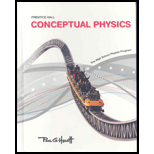
An electroscope is a simple device. It consists of a metal ball that is attached by a conductor to two fine gold leaves that are protected from air disturbances in a jar, as shown in the sketch. When the ball is touched by a charged object, the leaves that normally hang straight down spring apart. Why? (Electroscopes are useful not only as charge detectors, but also for measuring the amount of charge: the more charge transferred to the ball, the more the leaves diverge.)

To explain: The reason due to which the leaves will go apart.
Answer to Problem 39A
Due to charge induction, like charges develop in the leaves and both repel apart.
Explanation of Solution
Introduction:
When a charged object is placed near an object, then charges are induced in the object such as it acts as a dipole.
When a charged object is placed near a metal ball, then charges are induced in the metal ball. Due to charge induction, the metal ball becomes a dipole, in which positive and negative charges are set in the opposite direction. This process keeps going on till it reaches the gold leaves. When gold leaves are induced with charges then both leaves have similar charges on the surfaces which are in near contact. Thus, gold leaves feel repelling force by those induced charges, and both set apart.
Conclusion:
Thus, due to charge induction, like charges repel each other and leaves set apart.
Chapter 32 Solutions
Conceptual Physics: The High School Physics Program
Additional Science Textbook Solutions
Physics for Scientists and Engineers: A Strategic Approach, Vol. 1 (Chs 1-21) (4th Edition)
Tutorials in Introductory Physics
An Introduction to Thermal Physics
Physics (5th Edition)
Modern Physics
College Physics: A Strategic Approach (4th Edition)
 College PhysicsPhysicsISBN:9781305952300Author:Raymond A. Serway, Chris VuillePublisher:Cengage Learning
College PhysicsPhysicsISBN:9781305952300Author:Raymond A. Serway, Chris VuillePublisher:Cengage Learning University Physics (14th Edition)PhysicsISBN:9780133969290Author:Hugh D. Young, Roger A. FreedmanPublisher:PEARSON
University Physics (14th Edition)PhysicsISBN:9780133969290Author:Hugh D. Young, Roger A. FreedmanPublisher:PEARSON Introduction To Quantum MechanicsPhysicsISBN:9781107189638Author:Griffiths, David J., Schroeter, Darrell F.Publisher:Cambridge University Press
Introduction To Quantum MechanicsPhysicsISBN:9781107189638Author:Griffiths, David J., Schroeter, Darrell F.Publisher:Cambridge University Press Physics for Scientists and EngineersPhysicsISBN:9781337553278Author:Raymond A. Serway, John W. JewettPublisher:Cengage Learning
Physics for Scientists and EngineersPhysicsISBN:9781337553278Author:Raymond A. Serway, John W. JewettPublisher:Cengage Learning Lecture- Tutorials for Introductory AstronomyPhysicsISBN:9780321820464Author:Edward E. Prather, Tim P. Slater, Jeff P. Adams, Gina BrissendenPublisher:Addison-Wesley
Lecture- Tutorials for Introductory AstronomyPhysicsISBN:9780321820464Author:Edward E. Prather, Tim P. Slater, Jeff P. Adams, Gina BrissendenPublisher:Addison-Wesley College Physics: A Strategic Approach (4th Editio...PhysicsISBN:9780134609034Author:Randall D. Knight (Professor Emeritus), Brian Jones, Stuart FieldPublisher:PEARSON
College Physics: A Strategic Approach (4th Editio...PhysicsISBN:9780134609034Author:Randall D. Knight (Professor Emeritus), Brian Jones, Stuart FieldPublisher:PEARSON





